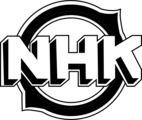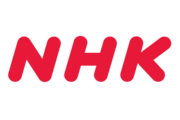NHK facts for kids

Logo used since 2020
|
|

Headquarters at the NHK Broadcasting Center in Shibuya, Tokyo
|
|
|
Trade name
|
NHK |
|---|---|
|
Native name
|
日本放送協会
|
|
Romanized name
|
Nippon Hōsō Kyōkai |
|
Formerly
|
Tokyo/Osaka/Nagoya Broadcasting Station (1925–1926) Broadcasting Corporation of Japan (English name 1926–1950) |
| Statutory corporation chartered under the Broadcasting Act of 1950 | |
| Industry | Broadcast radio, television and online |
| Predecessor | Tokyo Broadcasting Station |
| Founded | 6 August 1926 (original incarnation and brand) 1 June 1950 (current incarnation) |
| Founder | Gotō Shinpei |
| Headquarters | NHK Broadcasting Center, Jinnan,
,
Japan
|
|
Area served
|
Japan Worldwide (NHK World-Japan) |
|
Key people
|
|
| Subsidiaries |
|
The Japan Broadcasting Corporation (Japanese: 日本放送協会, Hepburn: Nippon Hōsō Kyōkai), better known as NHK, is Japan's national public broadcaster. Think of it like a TV and radio company for the whole country. It's a special type of company called a statutory corporation, which means it was created by a government law.
Instead of being paid for by commercials, NHK is funded by a license fee that people in Japan with a TV pay. This helps it stay focused on making quality programs for the public.
NHK runs several TV and radio channels. It has two channels that broadcast across the country on regular TVs: NHK General TV and NHK Educational TV. It also has satellite channels and three radio networks.
For people outside of Japan, NHK has an international service called NHK World-Japan. This includes TV channels and a radio service, so people around the globe can learn about Japan. NHK was also a pioneer in broadcasting, being the first in the world to show programs in high-definition and super-sharp 8K resolution.
Contents
The Story of NHK
NHK's journey began in 1924 with a small radio station in Tokyo. In 1925, this station, along with others in Osaka and Nagoya, started broadcasting. A year later, in 1926, they all joined together to form the first version of NHK. The idea was inspired by the BBC in the United Kingdom.
From Radio to TV
In the 1930s, NHK started broadcasting on shortwave radio to other countries. This service was called Radio Japan. During World War II, the government had control over all news broadcasts. After the war, a new law in 1950 made NHK an independent company supported by its listeners. This law also allowed other commercial TV stations to start up in Japan.
NHK launched its first television channel in 1953. This was a huge step forward for entertainment and news in Japan. An educational channel followed in 1959, and color TV broadcasts began in 1960.
A major event for NHK was the 1964 Summer Olympics in Tokyo. These were the first Olympic Games to be widely shown on TV around the world. NHK built a new headquarters in Shibuya, Tokyo, just for the event. This building is still its main headquarters today.
Modern Broadcasting
NHK has always been at the front of new technology.
- Satellite TV: In the 1980s, NHK started broadcasting channels using satellites. This allowed them to reach even more homes.
- Digital TV: In 2000, NHK began broadcasting in digital format. By 2011, Japan had switched completely from old analog signals to digital TV, which gives a clearer picture and sound.
How NHK is Organized
NHK is a special corporation that operates under Japan's Broadcasting Act. Its main funding comes from license fees paid by viewers in Japan. The part of NHK that broadcasts to other countries, NHK World-Japan, is paid for by the Japanese government.
The Diet of Japan (the country's parliament) checks and approves NHK's budget each year. The Diet also chooses a 12-member board of governors who are in charge of overseeing NHK. A smaller group, called the executive board, manages the day-to-day work.
NHK's Channels and Services
NHK provides a wide range of radio and television services for people all over Japan.
Radio Stations
- NHK Radio 1: This is Japan's first-ever radio station, starting in 1925. It broadcasts news, information, and entertainment programs 24 hours a day.
- NHK Radio 2: This station focuses on educational programs. It also has news in other languages and weather reports.
- NHK-FM: This station plays a lot of music, especially classical music. It also broadcasts 24 hours a day.
Television Channels
- NHK General TV (NHK-G): This was Japan's first TV channel, launched in 1953. It shows a mix of news, dramas, sports, and entertainment for a general audience.
- NHK Educational TV (NHK-E): This channel is all about learning. It has many shows for children, as well as cultural and educational programs for all ages.
NHK also has satellite channels for more specialized shows:
- NHK BS: This channel shows international news, documentaries, sports, and entertainment.
- NHK BS Premium 4K: This channel offers cultural and entertainment shows in super-sharp 4K quality.
- NHK BS8K: For those with the newest TVs, this channel broadcasts in stunning 8K resolution.
The License Fee
NHK is funded by a system called a "reception fee" or license fee. The law says that anyone in Japan who has a device that can receive NHK broadcasts, like a TV, must pay this fee. The money is used to create programs without having to show lots of commercials.
The fee is the same for everyone, but there are discounts if you pay for many months at once. For someone paying yearly, the fee is about 12,765 yen for regular TV and 21,765 yen for both regular and satellite TV.
However, not everyone agrees with this system. Some people choose not to pay the fee, and this has led to public debate. There is even a political party, the NHK Party, that was formed to protest the fee.
What's on NHK?
NHK creates many different kinds of shows for all ages.
News and Emergency Reports
NHK is a trusted source for news in Japan. It provides local, national, and world news. One of its most important jobs is to provide emergency warnings. Because Japan has many earthquakes, NHK has a system that can broadcast earthquake warnings just seconds after one is detected. This gives people time to protect themselves. These warnings are in Japanese and also in English, Chinese, Korean, and Portuguese for tsunamis.
Sports
NHK broadcasts many popular sports. This includes traditional Japanese sumo wrestling, baseball, and soccer. It also provides major coverage of the Olympic Games. In fact, the first sports event ever shown on TV in Japan was a sumo tournament broadcast by NHK in 1952.
Music and Drama
The famous NHK Symphony Orchestra is sponsored by NHK. Every New Year's Eve, NHK broadcasts a very popular music show called Kōhaku Uta Gassen.
NHK is also known for its dramas. It produces a popular morning drama series called Asadora and a year-long historical drama series called the Taiga drama.
Shows for Kids
NHK has a long history of making great shows for children. One of the most famous is Okaasan to Issho (With Mother), which has been on the air since 1959. It is one of the longest-running children's shows in Japan.
Logo History
See also
 In Spanish: NHK para niños
In Spanish: NHK para niños
- Domo, the mascot of the NHK since 1998
- ISDB
- Japanese television programs
- Media of Japan
- NHK Science & Technology Research Laboratories
- Television in Japan
- TV Japan – a former Japanese/English-language cable network in the United States
- Ultra-high-definition television








